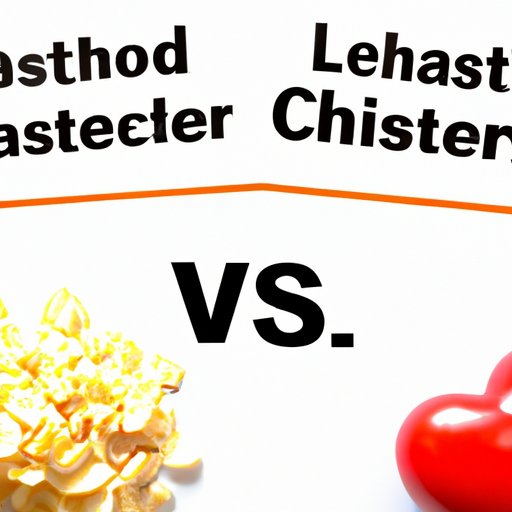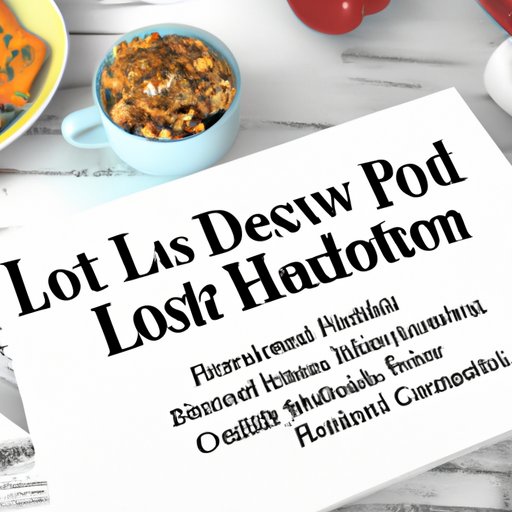Introduction
The low cholesterol diet is a type of eating plan designed to help lower blood cholesterol levels. High levels of cholesterol in the blood can increase your risk of heart disease, stroke, and other health conditions. A low cholesterol diet focuses on limiting foods that are high in saturated fat, trans fat, and dietary cholesterol, while emphasizing foods that are rich in fiber, lean proteins, and unsaturated fats.
Overview of Low Cholesterol Diet
A low cholesterol diet typically includes a variety of fruits, vegetables, whole grains, lean proteins, and healthy fats. It also limits or eliminates foods that are high in saturated fat, trans fat, and dietary cholesterol, such as red meat, full-fat dairy products, processed meats, and fried foods. Additionally, it encourages you to limit your intake of sugar and salt.
In addition to focusing on specific types of foods, a low cholesterol diet also emphasizes portion control. Eating smaller portions of food helps to control your calorie intake and can help you maintain a healthy weight, which can further reduce your risk of heart disease and other chronic conditions.

Benefits of Low Cholesterol Diet
Adopting a low cholesterol diet can have many benefits for your health. Research shows that reducing saturated fat, trans fat, and dietary cholesterol can lower your total cholesterol levels and reduce your risk of heart disease, stroke, and other health conditions.
A low cholesterol diet can also help you maintain a healthy weight. Eating smaller portions of nutrient-dense foods can help you feel fuller longer, which can reduce your cravings for unhealthy snacks and promote weight loss. Additionally, reducing your intake of processed and sugary foods can help reduce your risk of obesity and associated health conditions.
Interview a Registered Dietitian
To get more insight into how to follow a low cholesterol diet, I interviewed a registered dietitian (RD). The RD suggested adhering to the following tips when following a low cholesterol diet:
- Eat a variety of foods, including plenty of fruits and vegetables.
- Choose lean sources of protein, such as fish, skinless poultry, and beans.
- Limit foods that are high in saturated fat, trans fat, and cholesterol, such as red meat, full-fat dairy products, and processed meats.
- Choose healthier cooking methods, such as baking, roasting, steaming, and grilling.
- Read nutrition labels to identify hidden sources of saturated fat, trans fat, and cholesterol.
- Limit your intake of sugar and salt.
Review Studies on Low Cholesterol Diet
Several studies have evaluated the effects of a low cholesterol diet on cholesterol levels and overall health. A review of the available research found that reducing saturated fat, trans fat, and dietary cholesterol can significantly lower total cholesterol levels and reduce the risk of heart disease, stroke, and other health conditions.
The research also suggests that a low cholesterol diet can be beneficial for people who already have high cholesterol levels. Adopting this type of eating plan can help lower cholesterol levels and reduce the risk of developing additional health complications.
Create a Sample Meal Plan
Creating a meal plan can help you stay on track with a low cholesterol diet. When planning meals, aim to include a balance of macronutrients, such as carbohydrates, proteins, and fats. Here is an example of a sample meal plan:
- Breakfast – Oatmeal with berries and walnuts
- Lunch – Vegetable soup with grilled chicken and whole-grain crackers
- Snack – Apple slices with peanut butter
- Dinner – Baked salmon with roasted potatoes and steamed broccoli
In addition to focusing on the type and amount of food you eat, it is also important to pay attention to how you prepare your food. Choose healthier cooking methods, such as baking, roasting, steaming, and grilling, and avoid deep-frying and charbroiling.

Highlight Popular Low Cholesterol Recipes
Eating a low cholesterol diet doesn’t mean you have to sacrifice flavor. There are many delicious recipes that are low in saturated fat, trans fat, and dietary cholesterol. Here are some popular recipes to try:
- Baked Salmon with Roasted Potatoes and Steamed Broccoli
- Vegetable Soup with Grilled Chicken and Whole-Grain Crackers
- Grilled Vegetable Wrap with Hummus
- Quinoa Bowl with Avocado and Black Beans
- Stir-Fried Vegetables with Tofu
When making low cholesterol recipes, there are several tips to keep in mind. Use olive oil or vegetable oil instead of butter, choose leaner cuts of meat, and opt for low-fat dairy products. Additionally, use herbs and spices to add flavor to your meals without adding extra calories or fat.

Compare Low Cholesterol Diets to Other Healthy Diets
A low cholesterol diet is similar to other healthy eating plans, such as the Mediterranean diet and DASH diet. All three diets encourage you to focus on eating a variety of nutritious foods, such as fruits, vegetables, whole grains, lean proteins, and healthy fats. They also emphasize limiting processed and sugary foods, as well as saturated fat, trans fat, and dietary cholesterol.
However, there are some differences between the diets. For example, the Mediterranean diet encourages you to include healthy fats, like olive oil, while the DASH diet has a stronger emphasis on limiting sodium. Ultimately, it is important to find an eating plan that works best for you and your lifestyle.
Conclusion
Following a low cholesterol diet can provide many health benefits, such as reducing your risk of heart disease, stroke, and other chronic conditions. Eating a variety of nutrient-dense foods in moderation and choosing healthier cooking methods can help you adhere to the diet and reap the benefits. Additionally, by reading nutrition labels and comparing different healthy eating plans, you can find an eating style that works for you.
(Note: Is this article not meeting your expectations? Do you have knowledge or insights to share? Unlock new opportunities and expand your reach by joining our authors team. Click Registration to join us and share your expertise with our readers.)
